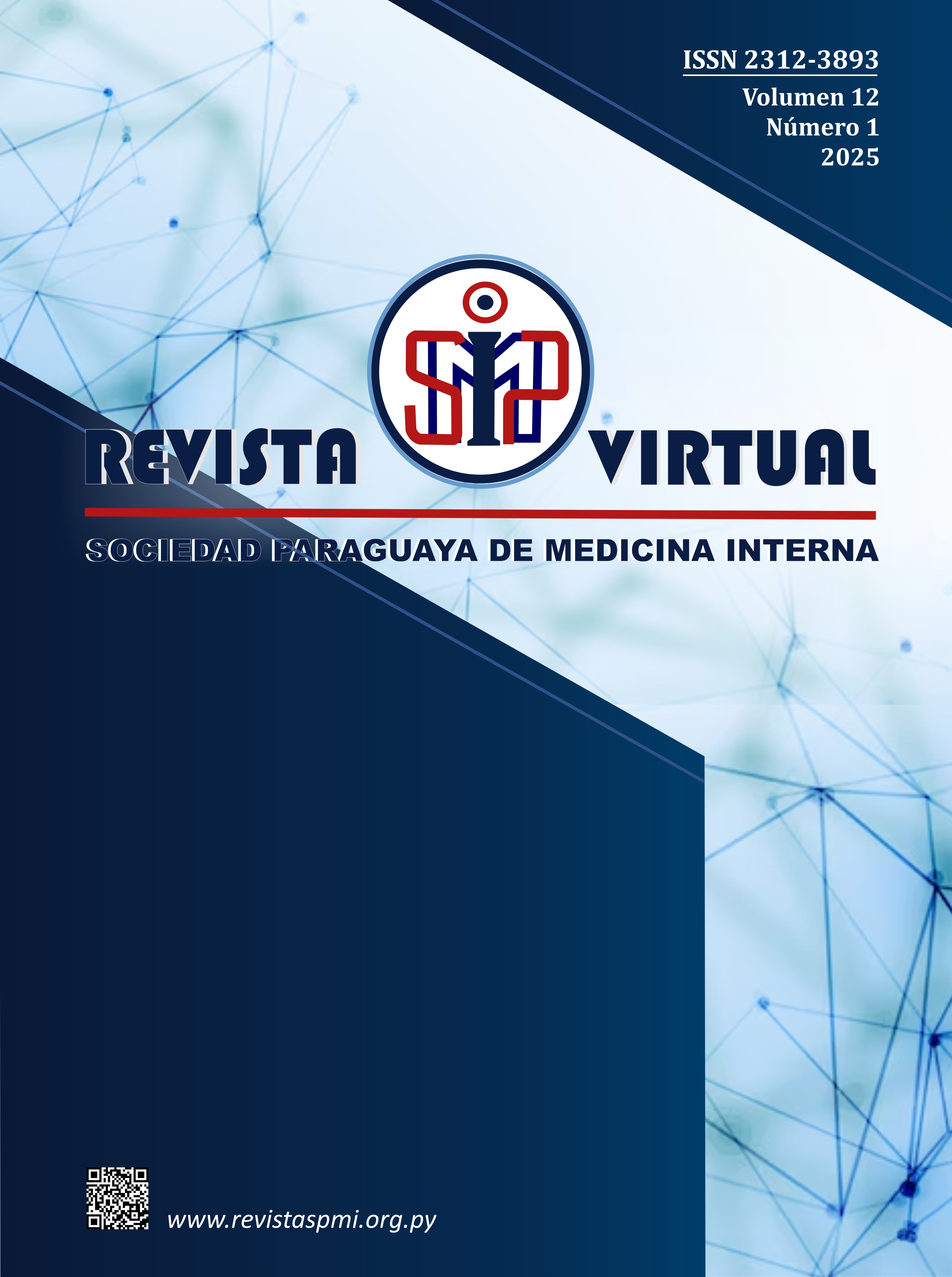Anemia nosocomial: prevalencia y características clínicas en pacientes adultos
Resumen
Introducción: la anemia nosocomial es definida como toda disminución de la hemoglobina durante la internación considerando los valores normales del ingreso. Se asume que este fenómeno no está asociado a pérdidas objetivables de sangre.
Objetivo: determinar la prevalencia de anemia nosocomial en pacientes adultos ingresados al Servicio de Clínica Médica en un hospital de referencia de Asunción, Paraguay, entre abril y octubre del 2023.
Metodología: se aplicó un diseño observacional, transversal. La muestra se conformó con varones y mujeres, mayores de edad, Se midieron variables demográficas y clínicas. Las variables fueron sometidas a estadística descriptiva.
Resultados: ingresaron al estudio 44 varones con mediana de edad 62 años y 45 mujeres con mediana de edad 58 años. Los diagnósticos más frecuentes fueron neumonía adquirida en la comunidad (26,9%), ictus (11,2%) e infección urinaria (10,1%). Considerando el sexo, se pudo determinar la aparición de anemia nosocomial a la semana de internación en 73% de los pacientes adultos que ingresaban con valores hematimétricos normales y en 46,2% de aquellos que ya ingresaban con anemia. La cantidad de flebotomías fue mayor en los sujetos que desarrollaron anemia.
Discusión: la frecuencia de anemia nosocomial es elevada y parece asociarse al elevado número de flebotomías.
Conclusiones: el descenso de hemoglobina de al menos 2 g/dL durante la primera semana de internación se observó en 73% de los sujetos que ingresaron con valores hematimétricos normales y en 46,2% de aquellos que ya ingresaron con anemia. Se recomienda evaluar la cantidad y necesidad del número de flebotomías durante la internación.
Citas
2. Villani R, Romano AD, Rinaldi R, Sangineto M, Santoliquido M, Cassano T, Serviddio G. Prevalence and risk factors for hospital-acquired anemia in internal medicine patients: learning from the “less is more” perspective. Intern Emerg Med [Internet]. 2023 [cited 2024 May 19]; 18:177–183. Available from: doi: https://doi.org/10.1007/s11739-022-03147-x
3. Koch CG, Li L, Sun Z, Hixson ED, Tang A, Phillips SC, et al. Hospital-acquired anemia: Prevalence, outcomes, and healthcare implications. J Hosp Med [Internet]. 2013 [cited 2024 May 19];8(9):506–12. Available from: https://pubmed.ncbi.nlm.nih.gov/23873739/ Subscription required
4. Czempik PF, Wilczek D, Herzyk J, Krzych ŁJ. Hospital-acquired anemia in patients hospitalized in the intensive care unit: A retrospective cohort study. J Clin Med [Internet]. 2022 [cited 2024 May 19];11(14):3939. Available from: doi: https://doi.org/10.3390/jcm11143939
5. Jackson Chornenki NL, James TE, Barty R, Liu Y, Rochwerg B, Heddle NM, et al. Blood loss from laboratory testing, anemia, and red blood cell transfusion in the intensive care unit: A retrospective study. Transfusion [Internet]. 2020 [cited 2024 May 19];60(2):256–61. Available from: doi: https://doi.org/10.1111/trf.15649 Subscription required
6. Fischer DP, Zacharowski KD, Meybohm P. Savoring every drop - vampire or mosquito? Crit Care [Internet]. 2014 [cited 2024 May 19];18(3):306. Available from: doi: https://doi.org/10.1186/cc13884
7. Witosz K, Wojnarowicz O, Krzych ŁJ. Iatrogenic blood loss due to daily laboratory testing and the risk of subsequent anaemia in intensive care unit patients: case series. Acta Biochim Pol [Internet]. 2021 [cited 2024 May 19];68(1):135–8. Available from: https://pubmed.ncbi.nlm.nih.gov/33682399/
8. Martin ND, Scantling D. Hospital-acquired anemia: A contemporary review of etiologies and prevention strategies. J Infus Nurs [Internet]. 2015 [cited 2024 May 19];38(5):330–8. Available from: doi: https://doi.org/10.1097/NAN.0000000000000121 Subscription required
9. Bressman E, Jhang J, McClaskey J, Ginzburg YZ. Tackling the unknowns in understanding and management of hospital acquired anemia. Blood Rev [Internet]. 2021[cited 2024 May 19]; 49:100830. Available from: doi: https://doi.org/10.1016/j.blre.2021.100830 Subscription required
10. Juárez-Vela R, Andrés-Esteban EM, Gea-Caballero V, Sánchez-González JL, Marcos-Neira P, Serrano-Lázaro A, et al. Related factors of anemia in critically ill patients: A prospective multicenter study. J Clin Med [Internet]. 2022 [cited 2024 May 19];11(4):1031. Available from: doi: https://doi.org/10.3390/jcm11041031
11. Makam AN, Nguyen OK, Clark Ch, Halm EA. Incidence, predictors, and outcomes of hospital-acquired anemia. J Hosp Med [Internet]. 2017 [cited 2024 May 19] ;12(5):317–22. Available from: https://pubmed.ncbi.nlm.nih.gov/28459899/
12. Shander A, Corwin HL. A narrative review on hospital-acquired anemia: Keeping blood where it belongs. Transfus Med Rev [Internet]. 2020 [cited 2024 May 19];34(3):195–9. Available from: doi: https://doi.org/10.1016/j.tmrv.2020.03.003 Subscription required
13. Eaton KP, Levy K, Soong Ch, Pahwa AK, Petrilli Ch, Ziemba JB, et al. Evidence-based guidelines to eliminate repetitive laboratory testing. JAMA Intern Med [Internet]. 2017 [cited 2024 May 19];177(12):1833–9. Available from: doi: https://doi.org/10.1001/jamainternmed.2017.5152 Subscription required
14. Bindraban RS, Van Beneden M, Kramer MHH, Van Solinge WW, Van De Ven PM, Naaktgeboren ChA, et al. Association of a multifaceted intervention with ordering of unnecessary laboratory tests among caregivers in internal medicine departments. JAMA Netw Open [Internet]. 2019 [cited 2024 May 19];2(7):e197577. Available from: doi: https://doi.org/10.1001/jamanetworkopen.2019.7577
15. Erard Y, Del Giorno R, Zasa A, De Gottardi S, Della Bruna R, Keller F, et al. A multi-level strategy for a long lasting reduction in unnecessary laboratory testing: A multicenter before and after study in a teaching hospital network. Int J Clin Pract [Internet]. 2018 [cited 2024 May 19];73(3):e13286. Available from: doi: https://doi.org/10.1111/ijcp.13286
16. Dehghan Nayeri N, Nadali J, Divani A, Hatefimoadab N. Ways to enhance blood transfusion safety: A systematic review. Florence Nightingale J Nurs [Internet]. 2022 [cited 2024 May 19];30(3):288–300. Available from: doi: https://doi.org/10.5152/fnjn.2022.21214
17. Helmer P, Hottenrott S, Steinisch A, Röder D, Schubert J, Steigerwald U, et al. Avoidable blood loss in critical care and patient blood management: Scoping review of diagnostic blood loss. J Clin Med [Internet]. 2022 [cited 2024 May 19];11(2):320. Available from: Available from: doi: https://doi.org/10.3390/jcm11020320
18. Chant C, Wilson G, Friedrich JO. Anemia, transfusion, and phlebotomy practices in critically ill patients with prolonged ICU length of stay: A cohort study. Crit Care [Internet]. 2006 [cited 2024 May 19];10(5):R140. Available from: https://pubmed.ncbi.nlm.nih.gov/17002795/
19. Martínez Díaz AL, Aveiro AC. Características clínicas de la anemia intrahospitalaria. Rev Nac (Itauguá) [Internet]. 2019 [citado 19 May 2024];11(1):56–67. Disponible en: doi: https://doi.org/10.18004/rdn2019.0011.01.056-067
20. Hamid M, Naz A, Alawattegama LH, Steed H. The prevalence of anaemia in a district general hospital in the United Kingdom. Cureus [Internet]. 2021 [cited 2024 May 19];13(5):e15086. Available from: doi: https://doi.org/10.7759/cureus.15086
21. Thavendiranathan P, Bagai A, Ebidia A, Detsky AS, Choudhry NK. Do blood tests cause anemia in hospitalized patients? The effect of diagnostic phlebotomy on hemoglobin and hematocrit levels. J Gen Intern Med [Internet]. 2005 [cited 2024 May 19];20(6):520–4. Available from: https://pubmed.ncbi.nlm.nih.gov/15987327/
22. Holland J, Peralta RM, Moss RL, Feane K, Uprichard J. A single-centre review of iatrogenic anaemia in adult intensive care. Transfus Med [Internet]. 2020 [cited 2024 May 19];30(3):196–200 Available from: doi: https://doi.org/10.1111/tme.12674 Subscription required
23. Whitehead NS, Williams LO, Meleth S, Kennedy SM, Ubaka-Blackmoore N, Geaghan SM, et al. Interventions to prevent iatrogenic anemia: A laboratory medicine best practices systematic review. Crit Care [Internet]. 2019 [cited 2024 May 19];23(1):278. Available from: doi: https://doi.org/10.1186/s13054-019-2511-9
24. Yarbrough PM, Kukhareva PV, Horton D, Edholm K, Kawamoto K. Multifaceted intervention including education, rounding checklist implementation, cost feedback, and financial incentives reduces inpatient laboratory costs. J Hosp Med [Internet]. 2016 [cited 2024 May 19];11(5):348–54. Available from: doi: https://doi.org/10.1002/jhm.2552 Subscription required
25. Shander A, Hardy JF, Ozawa S, Farmer SL, Hofmann A, Frank SM, et al. A global definition of patient blood management. Anesth Analg [Internet]. 2022 [cited 2024 May 19];135(3):476–88. Available from: doi: https://doi.org/10.1213/ANE.0000000000005873
26. Koch CG, Li L, Sun Z, Hixson ED, Tang AS, Phillips SC, et al. From bad to worse: Anemia on admission and hospital-acquired anemia. J Patient Saf [Internet]. 2017 [cited 2024 May 19];13(4):211–6. Available from: doi: https://doi.org/10.1097/PTS.0000000000000142 Subscription required
27. Peralta R, Gamarra Fleitas F, Gómez Fernández MN, Vaesken Rojas J, Frutos López RD, Galeano Vera SM. Características clínicas de la anemia en la enfermedad renal crónica de pacientes del Hospital Nacional en 2018. Rev virtual Soc Parag Med Int [Internet]. 2019 [citado 19 May 2024];6(1):11–20. Disponible en: doi: https://doi.org/10.18004/rvspmi/2312-3893/2019.06(01)11-020

















